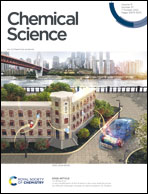The mechanism of Fe induced bond stability of uranyl(v)†
Abstract
The stabilization of uranyl(V) (UO21+) by Fe(II) in natural systems remains an open question in uranium chemistry. Stabilization of UVO21+ by Fe(II) against disproportionation was also demonstrated in molecular complexes. However, the relation between the Fe(II) induced stability and the change of the bonding properties have not been elucidated up to date. We demonstrate that U(V) – oaxial bond covalency decreases upon binding to Fe(II) inducing redirection of electron density from the U(V) – oaxial bond towards the U(V) – equatorial bonds thereby increasing bond covalency. Our results indicate that such increased covalent interaction of U(V) with the equatorial ligands resulting from iron binding lead to higher stability of uranyl(V). For the first time a combination of U M4,5 high energy resolution X-ray absorption near edge structure (HR-XANES) and valence band resonant inelastic X-ray scattering (VB-RIXS) and ab initio multireference CASSCF and DFT based computations were applied to establish the electronic structure of iron-bound uranyl(V).



 Please wait while we load your content...
Please wait while we load your content...